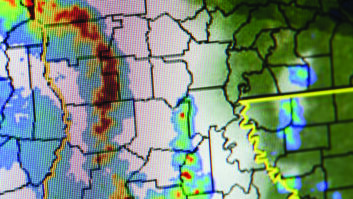
This article originally appeared in TV Technology.
The standard for the Mobile Emergency Alert System is expected to be finalized by March, according to broadcast consultant John Lawson.
“We’re also working closely with the Advanced Television Systems Committee, which is expected to finish standardization of Mobile EAS by March,” he said in an announcement about the M-EAS demo at CES in Las Vegas next week. M-EAS will provide rich media emergency alerts to mobile DTV devices.
Elgato, a manufacturer of mobile DTV receiver peripherals, and Siano, the chipset maker, are working on M-EAS compatible platforms, Lawson said, as is LG Electronics.
Prototype LG smartphones at CES will offer not only audio and visual indications of emergency alerts, but also a vibrating mode to notify all users, including those with vision or hearing loss, about an emergency.The simulations will be based on national and local emergency scenarios, including a hurricane threat in North Carolina, a tornado in the Northeast and an impending tsunami on the West Coast.
The 2013 CES M-EAS demonstrations are being conducted with the support of the Public Broadcasting Service; LG Electronics, which developed mobile EAS receivers; LG’s Zenith subsidiary, which provided technical support and funding; and Harris Broadcast, which equips TV stations with the necessary equipment. M-EAS requires no additional spectrum and is a “dual-use” of existing TV transmitters and towers. Standards-based equipment to upgrade stations for mobile DTV transmission is available commercially.
Purveyors say the M-EAS system would complement the recently activated 90-character, cellular-based text emergency alert system. In part, because it provides much deeper, multimedia opportunities with video, graphics, audio and text; and because it does not suffer chokepoints during high-traffic periods like cell networks often do.
“Mobile DTV will be a significant enhancement for local public safety communications because millions of devices will receive alerts simultaneously – just as easily as reception by a single device.Video, photos, graphics of evacuation routes, text and audio can all be transmitted through the system to reach anyone with a mobile device, including those with disabilities,” said Wayne Luplow, vice president for LG’s Zenith R&D subsidiary, which together with PBS developed the core technology enabling M-EAS.
The new alerting application developed for M-EAS utilizes existing standards for implementation. The U.S. broadcast standard for mobile television, the ATSC A/153 Mobile DTV Standard, uses Internet Protocol at its core. The use of IP allows the new application to be flexible and extensible. Data delivery, non-real-time delivery, and electronic service guides are all included. M-EAS is compliant with the international Common Alerting Protocol and designed for full incorporation into the U.S. Integrated Public Alert and Warning System.
The Mobile Emergency Alert System is being demonstrated again this year at CES. It will be on display at the CES Mobile TV TechZone in Central Hall, booth 14340.










